The tragedy of the Syrian Samaritan
There was once a governor who was traveling and was beset by terrorists on the road. They bombed his motorcade and left him for dead on the roadside.
Now, by chance, a fellow conservative politician was passing by and saw the wreckage of the terrorist attack. Angered and disgusted, he immediately made plans to ban immigrants from predominantly Muslim countries. Pulling out his iPad, he changed his social media profile picture. There, standing amid the still-burning cars, he began to draft legislation and a press release to refuse any Muslim refugees, to create a religious test for immigrants, and to restrict Islamic activity in his state. He took photos of the scene and plastered the pictures online as evidence that Muslims and refugees are dangerous. The photos immediately went viral. The politician went away feeling righteous and justified.
Likewise, a progressive Christian pastor passed by and saw the aftermath of the terrorist bomb and the half-dead governor. The pastor had also just seen the viral campaign to ban Muslims from the state. Disgusted and angry, he immediately began to tweet Bible verses about welcoming immigrants, and he started a petition for people of faith to support Muslims and refugees. He went away feeling righteous and justified.





